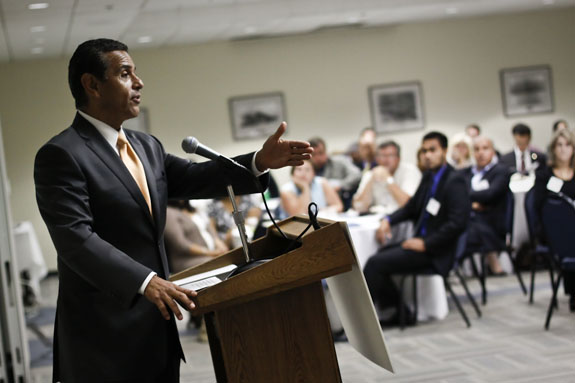Tough Jobs Climate Hits Los Angeles’ Inner City Neighborhoods Hardest

Faces of L.A.’s Jobless: A Neon Tommy Special Report >>>
Three years after the federal stimulus package pumped crucial funds into the city of Los Angeles’ youth unemployment budget, civic and private organizations charged with finding work for young Angelenos are watching their financial support evaporate.
Last year, Los Angeles received roughly $18.5 million in federal assistance to sponsor youth job opportunities programs, such as paid summer internships, career advice and education. But without an additional federal jobs bill, that money will not be there next year.
The truncation of employment services has hit the most impoverished parts of Los Angeles – particularly pockets of East and South Los Angeles – the hardest, exacerbating the problem of how to employ the nation’s next generation of workers.
“It’s just harder for young people to compete,” Lisa Salazar, the acting chief of program operations for the Los Angeles Community Development Department. “Without those blue-collar jobs – manufacturing jobs – young people are often competing with adults who are out of work and have experience.”
In parts of the city where youth unemployment is endemic, the ongoing jobs crisis is only aggravating the problem.
In fact, the unemployment rate in pockets of East and South Los Angeles, for example, are as high as 50 percent for Angelenos between the ages of 17-24, explained Robert Gutierrez, director of the Archdiocesan’s Youth Employment Services (AYE) in Los Angeles – twice as high as the national youth unemployment rate.
“I don’t think it’s a healthy society when you have that many young people out of work,” Gutierrez, who presides over the AYE, a privately run Catholic charity, said.
In California, 33.7 percent of youth 16-19 that are actively seeking employment are without jobs, according David Eder, a senior analyst for Los Angeles’s Workforce Investment Board. And while Los Angeles’ overall youth unemployment figures hover around the state average, evaporating government funds for employment programs are striking the city’s disadvantaged neighborhoods the hardest.
“When you look at South Los Angeles, there are not a lot of opportunities, period,” Salazar said. “You don’t the manufacturers, the malls, the supermarkets; places where kids could get jobs.”
With a high school dropout rate of nearly 50 percent, the need for youth employment programming in Los Angeles is at an all-time high. But Salazar, who has worked in youth unemployment services for over 20 years, said the evaporation of government funds supporting such programming is the major obstacle for 2012.
Los Angeles received $24 million in 2008 from the federal stimulus package specifically to help fund youth employment initiatives. But that money, along with state support, has dried up, forcing Salazar and her staff to rely more on private donations to finance youth employment initiatives.
“This past summer, we didn’t get any money from the state for youth [unemployment programming],” Salazar said.
Instead, the city relied on private donations – including a $1 million grant from Walmart – to fund their employment initiatives, Salazar said. Whether those donations will be available next year remains uncertain.
So why have youth employment services been placed on the chopping block?
Up until 1999, the city was receiving an average of $24 million in federal funds from the Workforce Investment Act per year, Salazar said. The government money allowed Los Angeles to provide paid work experience for 17,000 teens that summer.
Evidently, the good times have come to and end.
“It went from $24 million to zero almost overnight,” Salazar said.
In the interim, the city adjusted to the policy change by shuffling revenue from the city housing authority, for example, to pay for such programs.
But as funding from local, state and the federal government continue to evaporate, private philanthropic agencies – such as the AYE – are emerging as the most viable avenue to employ underprivileged youth.
However, even private charities are not impervious to the tough economic climate, Gutierrez said.
“We usually put more than 2,000 young people to work each summer [in Los Angeles],” Gutierrez, the AYE director, said. “This year, we’ll be lucky if we hit 900.”
Youth employment programmers are also struggling to deal with a new demographic of young people unable to find work in the rough jobs climate.
Kendra Madrid, the assistant director of the Los Angeles Youth Opportunities Movement in Watts, said college graduates are now among those that come to her office seeking employment assistance, a phenomena rarely seen before the 2008 recession.
“What many college graduates here hear from employers is that they don’t have the experience,” Madrid said.
Young Angelenos are no longer competing just with each other, but “people that were laid off, people with degrees, even people with Masters,” Salazar said.
For Salazar, the biggest difference she’s seen in her 22 years working in youth employment in Los Angeles is the level of competition young people face in the overall job pool.
For now, city officials are hoping for some federal assistance to fund youth employment programs. President Barack Obama’s American Jobs Act, for example, would have provided the city with necessary funds for youth employment services.
But with the bill fragmented, Salazar said she isn’t counting on the money for next summer.
“If we don’t invest in young people – if we don’t get the job act passed where there is an investment – I think we are going to loose a whole generation of young people who will make up our future workforce,” Salazar said.
Contact senior news editor Benjamin Gottlieb here.
Best way to find more great content from Neon Tommy?
Or join our email list below to enjoy the weekly Neon Tommy News Highlights.



